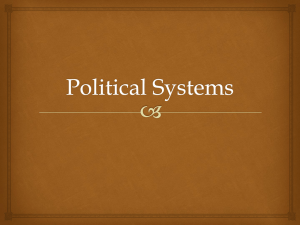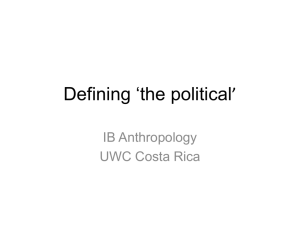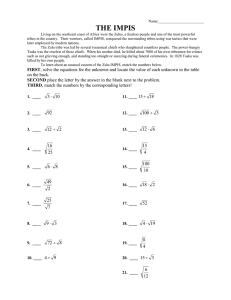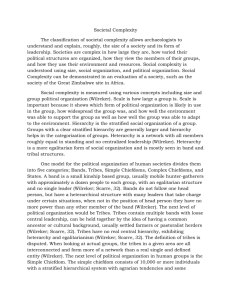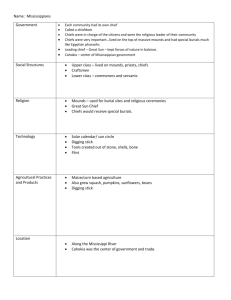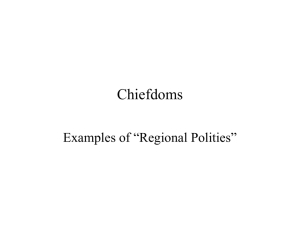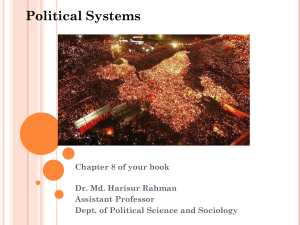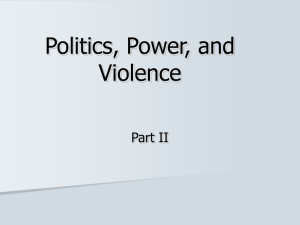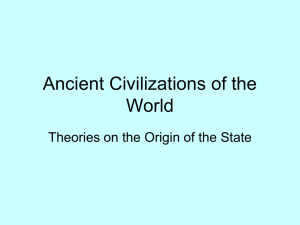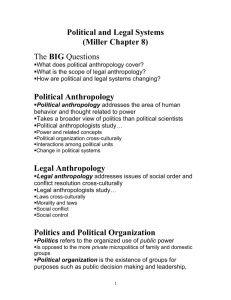The Evolution of Human Society--lecture notes.doc
advertisement
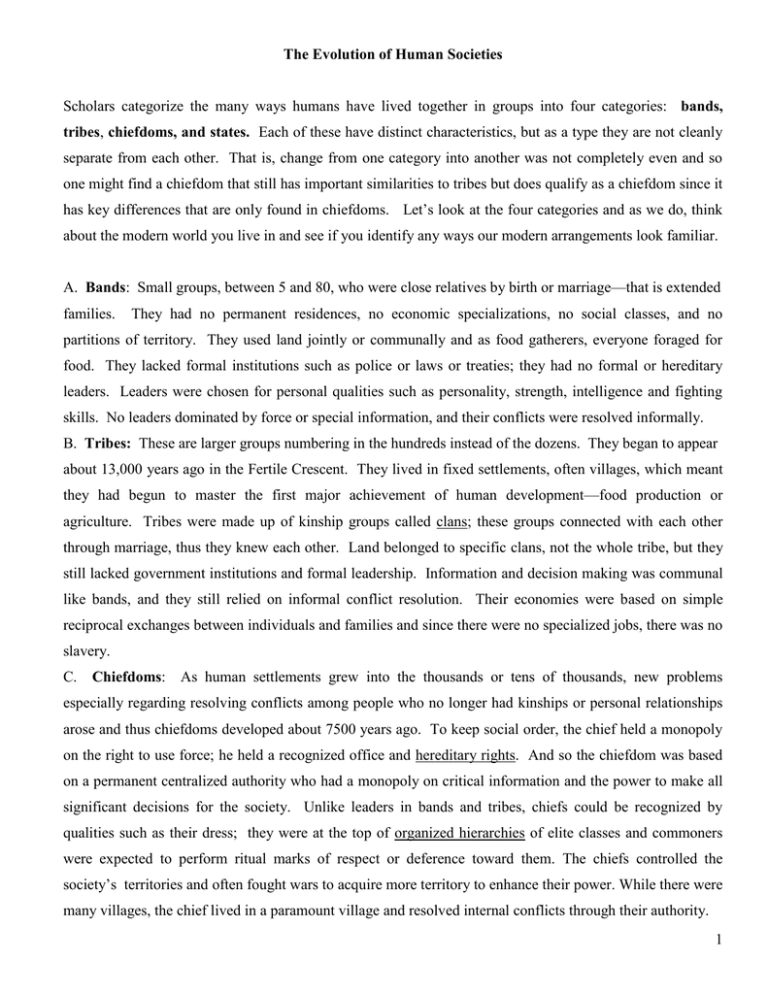
The Evolution of Human Societies Scholars categorize the many ways humans have lived together in groups into four categories: bands, tribes, chiefdoms, and states. Each of these have distinct characteristics, but as a type they are not cleanly separate from each other. That is, change from one category into another was not completely even and so one might find a chiefdom that still has important similarities to tribes but does qualify as a chiefdom since it has key differences that are only found in chiefdoms. Let’s look at the four categories and as we do, think about the modern world you live in and see if you identify any ways our modern arrangements look familiar. A. Bands: Small groups, between 5 and 80, who were close relatives by birth or marriage—that is extended families. They had no permanent residences, no economic specializations, no social classes, and no partitions of territory. They used land jointly or communally and as food gatherers, everyone foraged for food. They lacked formal institutions such as police or laws or treaties; they had no formal or hereditary leaders. Leaders were chosen for personal qualities such as personality, strength, intelligence and fighting skills. No leaders dominated by force or special information, and their conflicts were resolved informally. B. Tribes: These are larger groups numbering in the hundreds instead of the dozens. They began to appear about 13,000 years ago in the Fertile Crescent. They lived in fixed settlements, often villages, which meant they had begun to master the first major achievement of human development—food production or agriculture. Tribes were made up of kinship groups called clans; these groups connected with each other through marriage, thus they knew each other. Land belonged to specific clans, not the whole tribe, but they still lacked government institutions and formal leadership. Information and decision making was communal like bands, and they still relied on informal conflict resolution. Their economies were based on simple reciprocal exchanges between individuals and families and since there were no specialized jobs, there was no slavery. C. Chiefdoms: As human settlements grew into the thousands or tens of thousands, new problems especially regarding resolving conflicts among people who no longer had kinships or personal relationships arose and thus chiefdoms developed about 7500 years ago. To keep social order, the chief held a monopoly on the right to use force; he held a recognized office and hereditary rights. And so the chiefdom was based on a permanent centralized authority who had a monopoly on critical information and the power to make all significant decisions for the society. Unlike leaders in bands and tribes, chiefs could be recognized by qualities such as their dress; they were at the top of organized hierarchies of elite classes and commoners were expected to perform ritual marks of respect or deference toward them. The chiefs controlled the society’s territories and often fought wars to acquire more territory to enhance their power. While there were many villages, the chief lived in a paramount village and resolved internal conflicts through their authority. 1 Other elites served as general bureaucrats who oversaw the chief’s commands and crafts specialists appeared. Agriculture provided most food and surplus food produced by commoners went to feed the chiefs and other elites. Any luxury goods produced by craftsmen or obtained through trade were reserved for the chiefs. The chief’s relatives held special privileges and since economic specialization had developed, slavery also appeared. While reciprocal exchange still occurred, a new system of redistribution required commoners to give a large portion of whatever they produced to the chiefs and their elites. Called tributes, chiefs not only claimed goods but also the labor of commoners to build public works such as irrigation systems and lavish tombs, honoring themselves and serving as visible signs of their power. In effect, chiefdoms were societies of inequality in which wealth was transferred from commoners to upper classes; that wealth might benefit only the elites or it might be redistributed in ways that benefited the whole group. At the same time that this centralized power developed among humans, sets of ideas or ideologies, developed that justified the authority of the rulers often through religious beliefs. That is, accompanying the growth of political power was the growth of religious institutions, and many chiefs justified their power through a claim to divine authority. Sometimes the chief was the political leader and the high priest and sometimes the chiefs provided support to the priests by building elaborate temples as public works and designating an official religion. D. States: The modern state developed with at least 50,000 people but today their populations number in the millions; they arose first around 3700 B.C. in the Middle East. The most important characteristic of states was that they were organized on political and territorial boundaries, not kinship lines as were bands, tribes and chiefdoms. States had true cities, with a capital city, and might have more than one language and culture; as states conquered other states and became empires, they became multi-ethnic and multi-lingual. Early states had hereditary leaders but even in modern democracies, the leaders of the state monopolize the use of force and control the flow of information and decision-making. Centralized powers and tributes--now called taxes--became far more extensive; control of land varied but socio-economic classes were welldeveloped. Elaborate bureaucracies appeared and conflicts were addressed through formal institutions of law, courts, and police. Laws were often written as the elites became literate. Economic specialization became complex and even farmers were not truly self-sufficient except in rare times such as the early American frontier of the British colonies. Most early states adopted slavery on a larger scale than chiefdoms had and while mass production of agriculture and more public works made more use of slave labor, a large scale of state warfare made more potential slaves available. Like chiefdoms, early states had state religions and standardized temples, and early kings were considered divine. The predominant trend in human society for the past 13,000 years or so has been the replacement of smaller, less complex social units to larger, more complex ones—states now rule all of the earth’s land area with the exception of Antarctica. 2
